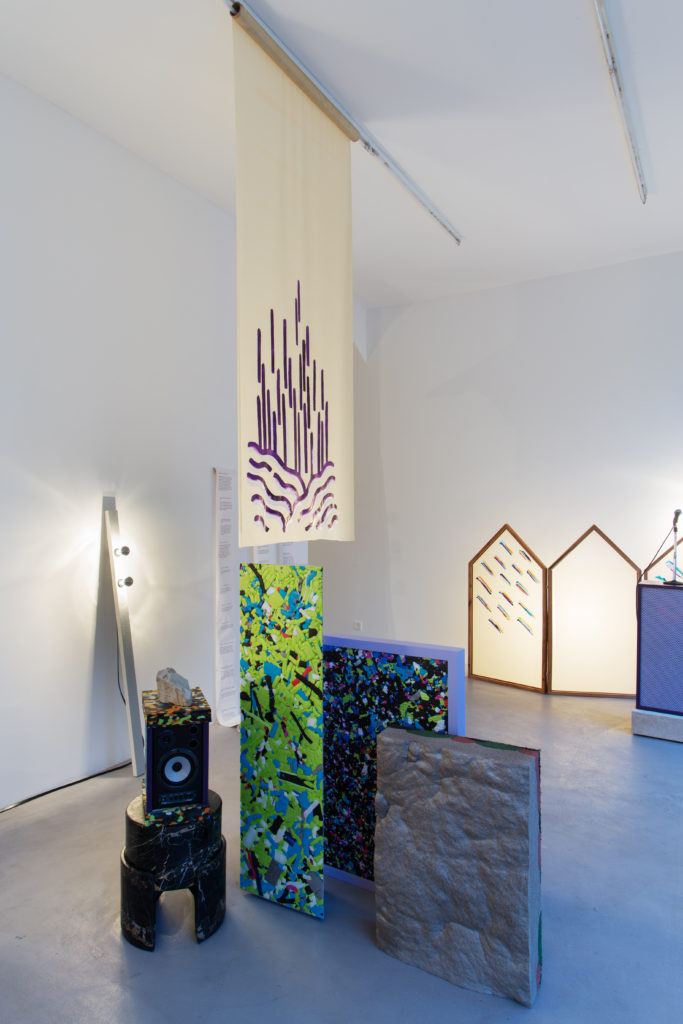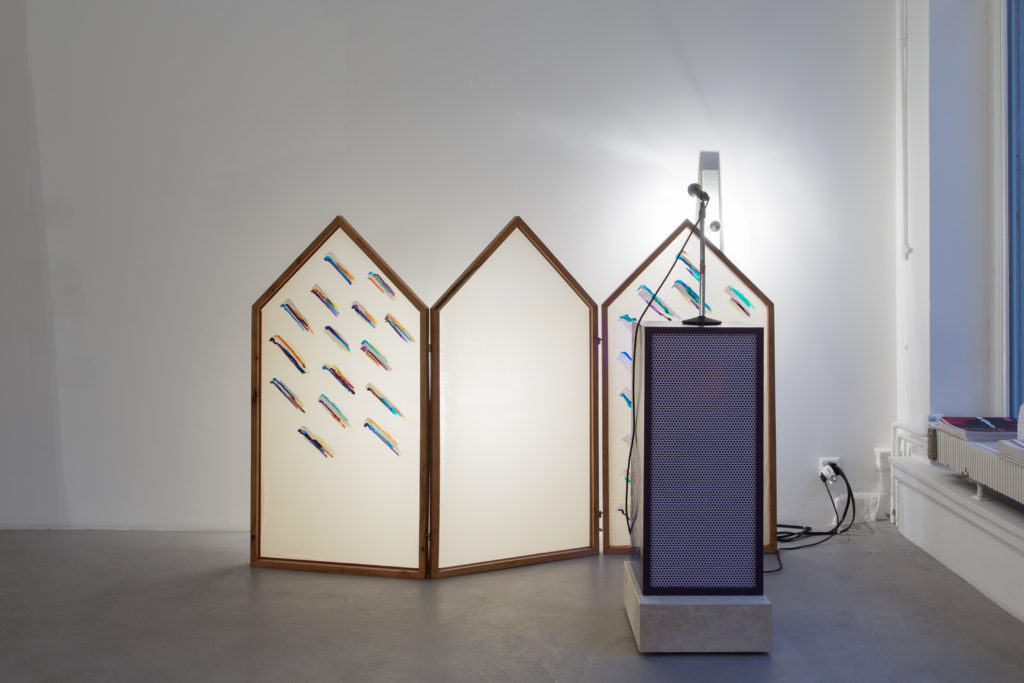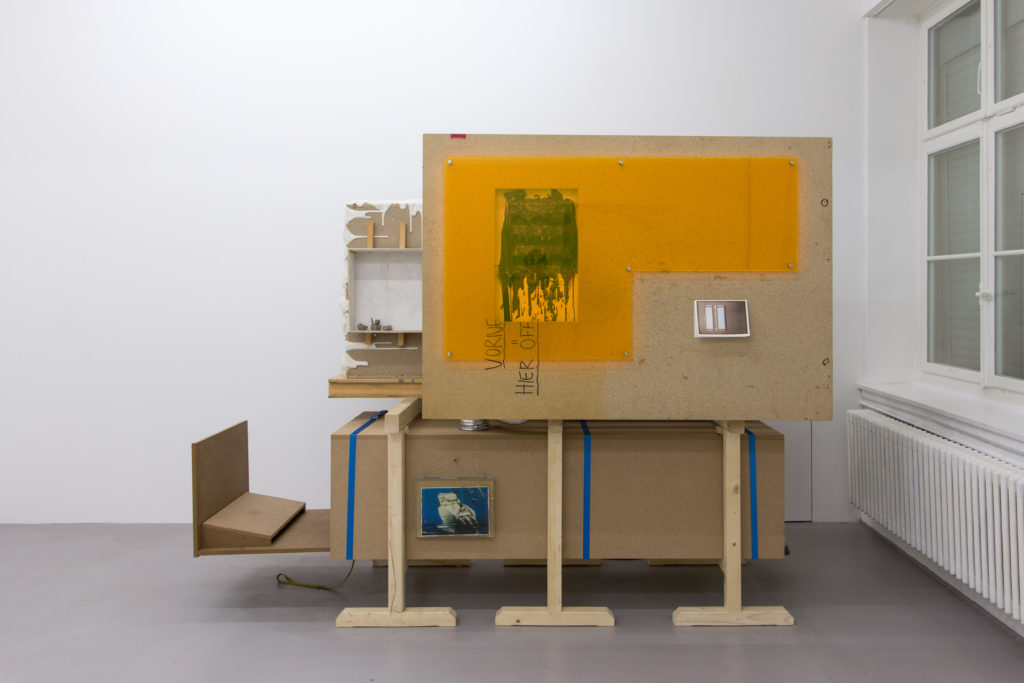Space is dwindling and inflating at an accelerated pace. Alongside that, self-expression can feel increasingly unprofitable within the realm of mass trend consumption. The Anyway part of it group exhibition confronts the basic use and method of the contemporary gallery today as site — making way for a more relational aesthetic discourse through ‘functional’ design and product. Featuring artists and collective Kueng Caputo, Patrick Hari and Clémence Seilles at Zürich’s BolteLang Gallery, and running January 20 to March 4, the installation explores both the utility and aesthetics of material practice today.

Curator Jeanette Apitz chooses to split the space into three, offering two rooms to the Zürich-based design duo Kueng Caputo, who collaborated with sound and video artist Seilles. Together, they initially used the gallery as an intensive residency area for the production of the works that were then displayed. With its large glass windows looking out onto the most walked street for contemporary art in Swiss city, the artists thus de-mystified the modes of cultural production during their initial working period to every passer-by who happened to peer into BolteLang. The trio then transformed it into a hyper-designed stage-like situation for censored performers all over the world for the remainder of the exhibition.
On entering Anyway part of it, one walks straight into the heart of their orchestrated stage, immediately assuming the role of audience member. It is cramped and overwhelming; the viewer has to step over and around stacked sub speakers, sound-proofing blocks, modular bass trap systems and a silent pulpit with a dead microphone. All the pieces are unique, predominately made from moulded, marbled plaster foam in clashing colours. Lime greens, mixed with lilacs, reds and acrid yellows are set jammed together in unison, not too dissimilar to the garish patterns you find on the interior seats of public transport – stain-proof and primary. One could also find references to the Memphis Group design collective, if looking at it with a more acute eye, with their infamous overwhelming maximalism and fondness for looping compositions, like their patented postmodern motif known as ‘bacteria.’ Blasting out of these heavily- adorned speakers is a playlist that is pinned up loosely on the adjacent walls, with artists like Fire EX, Pussy Riot, Lady Gaga, M.I.A and The Doors. The latter names are not necessarily the first that come to mind when one thinks of censored music. Yet, Lady Gaga was banned in Lebanon for offending Christianity in 2009, M.I.A’s 2007 hit ‘Paper Planes’ was abridged on MTV for its gunshots samples, and The Doors’ ‘Unknown Soldiers’ was prohibited in 1968 due to its anti-military message during the Vietnam War, and again during the Persian Gulf War. We know the stage and the immaterial nature of songs — especially in a modern world of hosting websites like Youtube and Soundcloud — have a far wider reach than most artworks do. Should artists, then, be localizing the tools and techniques of these blacklisted musicians as method not just ideology?

The third room in the exhibition is given over to Brazilian artist Hari, who approaches the overall theme of Anyway part of it through his own distinct artistic model, which overlaps into self-written cosmologies and dreamed experiences. His practice often materialises his own observed societal constellations and his ‘Muppet Villa – Dreaming Alone is a Boring Land’ is no exception. Sitting in the corner like a packed work ready for transportation rather than display, the piece is comical, a domestic microcosmos for the most basic human needs. Only a few meters wide and high, with its bed-like pull-out drawer, complete with chipboard pillow, one could naturally lie down inside its sleeping drawer, to rest or to die. This mobile home on wheels has a stacked quality to it, with shelves and display cabinets built into every available area with absolute precision for the un-functional functionality of this model for lived space. Adorning the outer structure are relics on display; a single piece of elephant dung with a tiny white mushroom parasitically living off its nutrients, birch kindling laid out on a wooden structure with individual dips – think of a wine rack but for twigs — clay models, and a photograph of an easy-chair set in resin. The artist hints at performance and simultaneously denies any use of it.

It is admittedly hard to define the exact narrative links that these four artists-come-designers materialise in Anyway part of it, but in a way that’s the very strength of the constellation on view. Offering a moment of reflection, or a dramatic unplugged pause, the viewer contemplates the purpose of art as a purely decorative or displayed gesture. Do Kueng Caputo and Clémence Seilles interrogate the relevance of a purely objective-based practice in a world that so desperately needs action rather than censorship? By combining the functional and the aesthetic, the viewer is drawn in by the visual admiration of the sublime, initially, but a secondary reading of functionality offers a new conceptual drive to the art object. Whether it’s a home or sound system, the object can live on in a more wide-scale collective sense, rather than being merely observed or displayed. Hari’s simplicity of aggressively maintaining the ability to hoard or embellish, even in the most restrictive living-conditions, also offers a further reading into design, as a social form. Juxtaposed by the intimate individual needs against mass consumerism, the work, like the exhibition asks, is design today offering us the ability to model a collective functioning future?**













